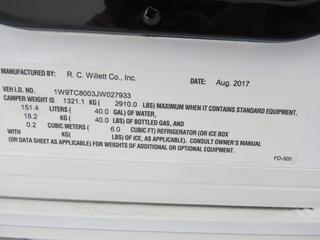Pickup trucks play a large role in the RV world. Obviously they make great tow/haul platforms for Truck-campers, Travel-trailers, and Fifth wheel campers.
Since my limited experience (and simple common sense) is with slide-in type truck campers, that is what I base the following comments on, but in many ways it applies to all types of towable/haulable RV's and the vehicles that move them.
The big conundrum seems to be with matching a slide-in camper to a pickup truck.
Facebook, Truck Camper Magazine, and several RV forums all feature articles or threads with long detailed essays on the magical & mystifying art of matching a camper to a truck.
The difficulties people have when accomplishing this simple task have always amazed me so perhaps some of you out there can help me understand it better...
Every vehicle manufactured in North America in the last 15 years has a Tread Act sticker on the B-column. The sticker states the exact payload allowable for that specific vehicle.
Any truck camper I have ever seen also has a VIN sticker stating the dry weight of the camper.
Plus camper manufacturer's web sites and sales brochures
always post the dry weight of their equipment.
With the wonders of the internet even a fool like me knows that the rule of thumb is to add 500 to 1000 pounds to the camper's dry weight and you will have a good idea of how much its loaded and ready to camp weight will be.
Sample camper dry weight sticker pictured below showing a 2910 Lb dry weight, (plus we add 800 Lb for gear) = actual weight of 3710 Lb...

.
.
Sample truck payload sticker shown below stating a 3823 Lb max permissible payload of the truck...

In the example above the camper fits the truck's payload rating rather nicely and it didn't require much effort (or intellect) to figure it out.
So my question is why all the confusion about matching a camper to a truck?
As a rookie truck-camper shopper myself, here are a few Fun-Facts I learned early in the game,
before I bought my first rig...
* If its on a dually truck it 'might' be overloaded, if its on a single rear wheel truck it's almost 'definitely' overloaded.
* Overloaded vehicles are dangerous and against the law.
* The tires & rims your truck ride on are usually the limiting factor on how much weight the rear axle can carry.
For most SRW vehicles that's an anemic 7000 pounds max!
* Installing Air-Bags or jamming steel wedges between the shackle pack and the lower overload leaf do NOT increase the GVWR of the truck.
* After-market equipment such as Air-bags, Helper springs, Anti-sway bars, etc... all suck up precious payload while doing nothing to increase the truck's GVWR.
* A CAT Scale is your friend. Its a good place to get a 'reality-check' if you already have the truck but no camper yet, and a
great place to go if you already have the complete rig and are experimenting with the art of load balancing.
Unfortunately for the RV rookie, the above items are seldom mentioned pre-purchase in the name of spoiling the sale, and seldom mentioned post-purchase in the name of political correctness.
<
go figure>
While I completely understand why a salesperson would sell a customer an improper camper-to-truck match up, I cant for the life of me understand why any consumer would buy it?
In this age of the information highway pre-sales research & knowledge is very abundant, so my question is; why are mismatched truck to camper issues so abundant and such a hot topic lately?
Recently RV forums and magazines have been loaded with articles trying to help people salvage their RV investment.
People that confidently spent their life savings on a new RV and placed something like a Lance 975 on the back of their RAM 2500 and swear that "she rides like a dream"
(Yeah... Just add a set of air-bags and you'll be fine)

So answer me this. . .
Why purposely buy a truck (or camper) that makes for a grossly overload rig and then defend that foolish action (and waste of money) vehemently?
Baffled in Buffalo,

-Jake-